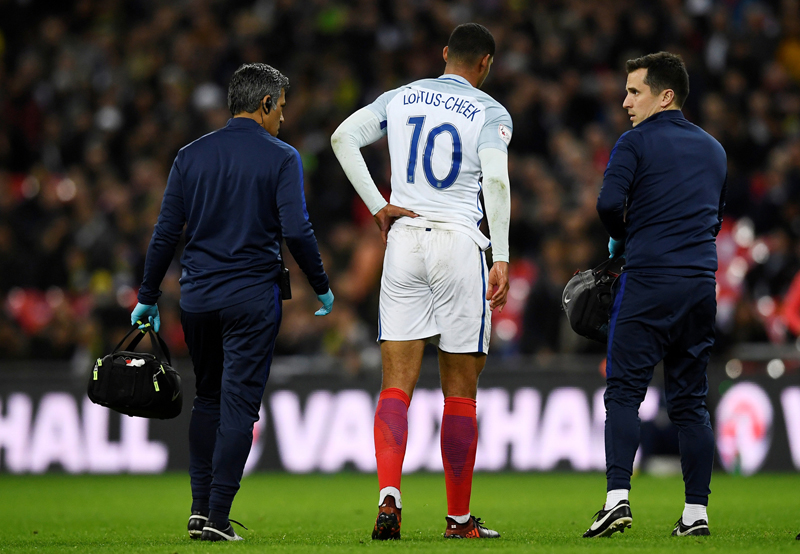Neural tension: don't let it hamper your free range of movement!
Although not widely appreciated, ‘neural tension’ injuries are surprisingly commonplace in sport. Trevor Langford explains what they are, and provides some simple self tests and management techniques
Most athletes are keen to optimise and enhance movement, which means thinking about the nervous system. ‘Neurodynamics’ is a term used to explain how the nerves move throughout the body to allow for effective movementJ Man Manip Ther. 2008, 16, 1, 8–22. A fundamental inhibitor of movement is tension within the nervous system, which is often referred to as ‘neural tension’. If you have suffered with a repetitive injury such as a hamstring strain or sciatica, this could be related to a neural tension element caused by a problem locally or elsewhere. Neural tension can present itself in either the upper limb or lower limb and distinct tests exist for both areas. In this article, we’ll focus on the lower limb with particular attention to the sciatic nerve. We’ll also explain how the nerves function throughout the body and how tension in a nerve can inhibit movement.What is neural tension?
Neurodynamics refers to the nerves’ ability to ‘slide’ effectively through various channels of the body, taking into account how the nerve is loaded from bony and muscular structures as well as other body systems tooJ Man Manip Ther. 2008, 16, 1, 8–22. There can be different locations, intensities and types of neural pain, and therefore the cause of any neural tension should be clearly identified.In a 2008 study, scientists described an effect of mobilising a nerve on a deceased personJ Man Manip Ther. 2008, 16, 1, 8–22. The results showed that performing passive movements increased fluid dispersion around the tibial nerve in the lower leg, indicating that mobilisation techniques could reduce swelling within the sheaths surrounding the nerve. In other word, impaired fluid dynamics within the nerve sheath could be a factor for the reduced ability of the nerve to slide.
A variety of functional positions in sporting movements can be impeded through neural tension. For example, stride length in running can be affected by a reduced ability to straighten the leg, resulting in symptoms of a muscle strain of the calf or hamstring at the back of the thigh. However, it is really important to not automatically assume that it is a typical muscle tear; the nerve pathways into the lower back and buttocks should also be considered. Another example is the cycling position on a road bike, which can become a problem if a cyclist is ‘neurally tight’, leading to pain into the lower back or the upper buttock region. In rowers with neural tension, this may present either as a muscle strain or as a lower back disorder.
If neural tension is identified, then it’s important to not only to perform exercises to help manage the problem, but to also look at the underlying movement patterns – eg gait pattern in runners, or the bike set up in cyclists, as these could this be a cause of neural tension For cyclists, if the bike set up is incorrect and the lower back, hips and the surrounding musculature is being loaded in the wrong way, then this could be a contributing factor in the occurrence of neural tension. (see figure 1).
FIGURE 1: PRACTICAL TECHNIQUES TO PREVENT NEURAL TENSION FROM OCCURRING
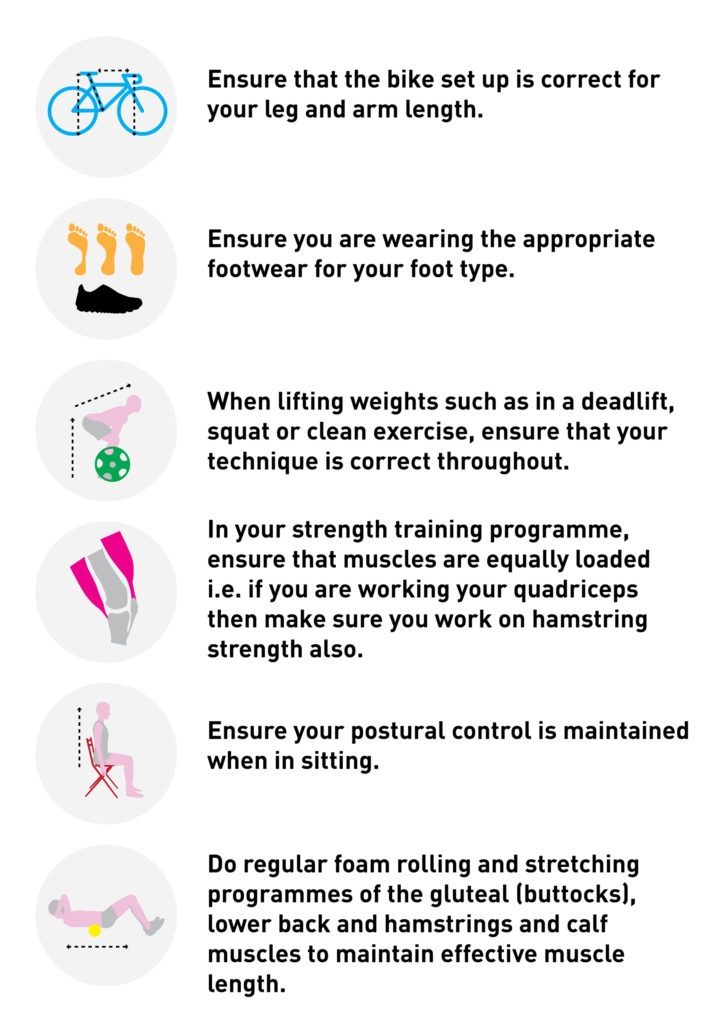
Causes of neural tension
Although this article isn’t intended to diagnose a problem you may be presenting with, it is intended to help you understand how a problem may present and the underlying issues involved. The nervous system follows a defined pathway through your body to stimulate different body tissues (eg fire motor neurons in muscles). At each segmental level in the spine, a nerve is distributed to supply a different area of the body whether it be an extremity or an area of the trunk.An impingement (pressure) on a nerve may occur due to joint degeneration – for example when the disc space narrows (figure 2a) or where there is an intervertebral disc lesion (figure 2b). There are different levels of disc lesions. The mildest is stage one – this is a disc bulge causing pressure on surrounding nerves, which may cause referred pain into different muscles depending on where in the spine the lesion is. A stage four lesion would cause far more nerve pressure, and much higher pain level in the extremities, with increased local pain in the spine too.
Muscle impingement around a nerve can also contribute to neural tension such as in piriformis syndrome involving the sciatic nerve. This condition often occurs in the fourth of fifth decade of life, and can affect those at all levels of activity statusJ Am Osteopath Assoc, 2008,108, 657-664. The piriformis is a small muscle that rotates the hip and although it is small in size it is a big player in terms of the sciatic nerve and sciatic nerve problems (see figure 3).
The piriformis and the sciatic nerve can interact in different ways and in 22% of the population, the sciatic nerve passes straight through the piriformis muscle (see centre diagram, figure 3). This relationship between the sciatic nerve and the piriformis is referred to as ‘primary piriformis syndrome’ which occurs in less than 15% of cases.
The other cause is ‘secondary piriformis syndrome pain’ where pain arises from either microtrauma or macrotrauma to the buttocks, which causes inflammation and/or muscle spasm, resulting in nerve compression from surrounding congestionJ Am Osteopath Assoc, 2008,108, 657-664. Microtrauma to the piriformis can occur from simple things like sitting on a hard surface or even sitting on an object in your back pocket. Macrotrauma can also be caused by repetitive loading and muscles imbalances around the pelvis.
FIGURE 2: DISC IMPINGEMENT AND LESION

FIGURE 3: PIRIFORMIS AND THE SCIATIC NERVE*
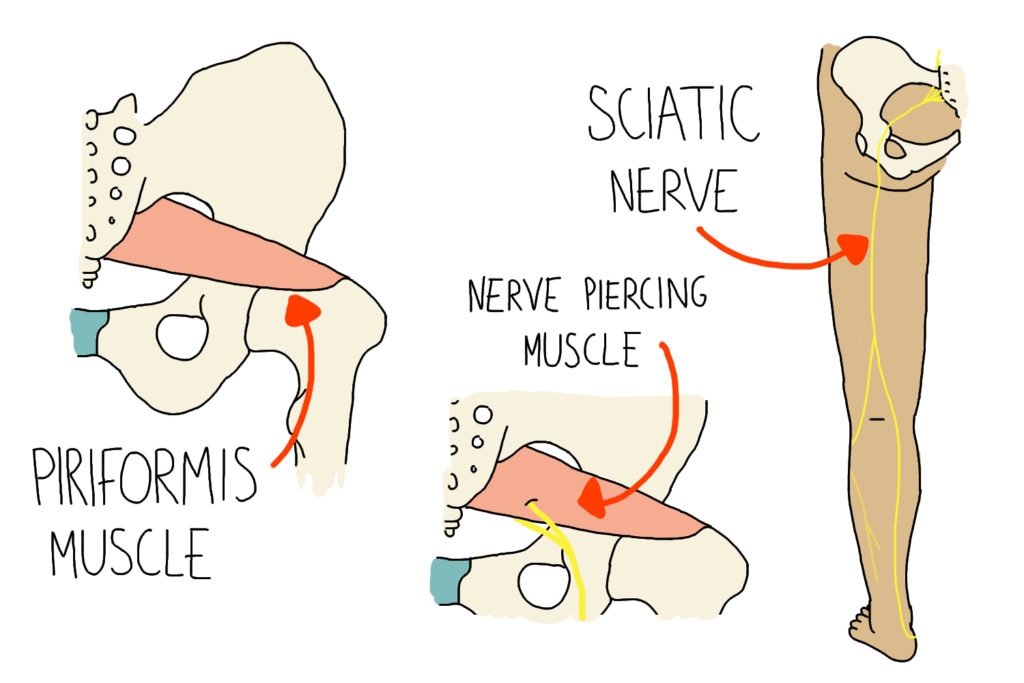
Injuries linked with neural tension
An athlete may experience recurring bouts of pain in a particular area of the body - for example in the soft tissues on the bottom of the foot (known as the plantarfascitis), or medial compartment syndrome of the lower leg, which can result in severe shin painJ Res Med Sci, Aug, 2012, 17, 8, 799–804. If, after treatments to these body parts, the symptoms don’t settle, a simple nerve tension test is worth performing. If this test is positive, it’s worth performing some simple nerve mobilisation techniques (see figure 5 later) to see if the symptoms start to alleviate.It is possible that an injury to the plantar fascia of the foot causes symptoms typical of plantarfascitis, but in actual fact there is some nerve root irritation originating from the lumbar vertebrae (L5/S1) in the base of the lower back, which is the actual cause. Likewise, athletes who have been diagnosed with a hamstring strain or hamstring tendinopathy (degeneration of tendon at the top of the thigh) might actually be suffering from neural tension affecting the sciatic nerve. Of course, it’s important to understand that there are often multiple factors involved in injury causation, which means neural tension may be an additional factor rather than the sole cause.
Self test for neural tension and treatment
The ‘slump test’ is a test frequently used in physiotherapy clinics to identify neural tension, and it may also expose a backrelated condition. The purpose is to apply tension to the neural network in a stage by stage process as shown in figure 4.If back pain or associated leg symptoms occur at any point during the test, the stage of the test and associated knee or ankle joint angles are noted as well as the pain intensity. If tension is felt at any point during the test, the head can be raised to look forwards; if the tension-related symptoms reduce, this is a sign that there is some neural tension.
If, when the head is raised, the symptoms don’t ease then this could be an indication that there is some muscle tightness present - perhaps as a result of isolated muscle shortening. The slump test is a sensitive test for identifying intervertebral disc lesions but should not be used in isolation to determine whether a back injury is presentJ Clin Rheumatol. 2008, Apr, 14, 2, 87-91.
FIGURE 4: SLUMP TEST
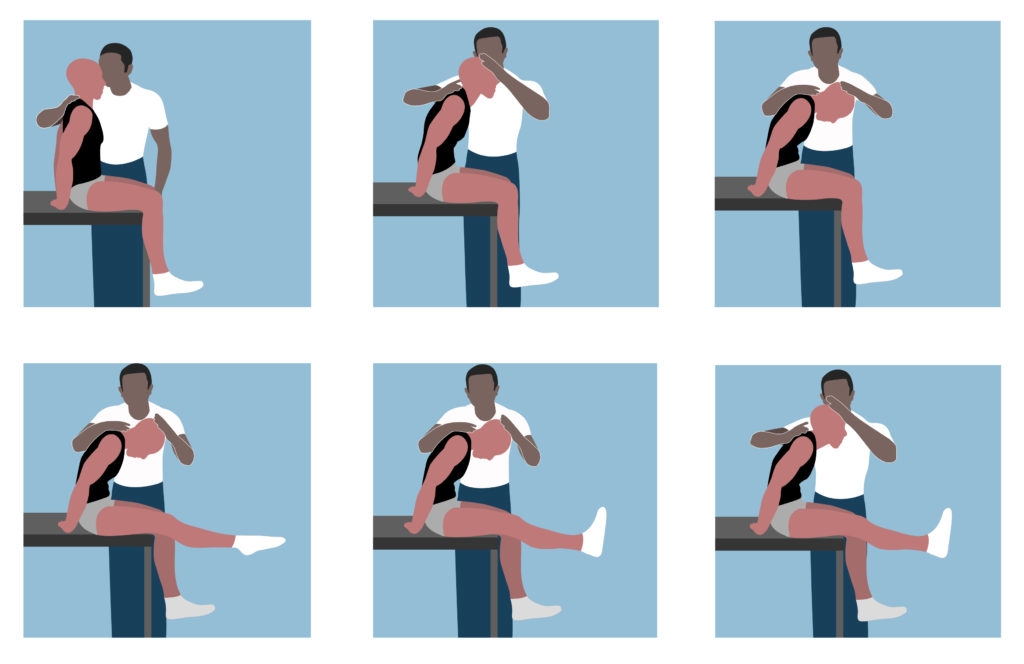
Although the slump test is used as an assessment technique, it is also used as a treatment technique also. Physiotherapists use tensioning and sliding techniques in the slump position and this is well worth trying if the slump test is positive for tension in the nerve.
In a nerve sliding position, two joints work simultaneously to counterbalance the forces applied at one jointJ of Ortho & Sports Phys Thera, Oct, 2015, 45, 10, 731-737. A nerveslide exercise can involve actions at the head and neck and at the opposite end of the involved extremities (see figure 5). Nerve slides are typically performed over 30 repetitions, and regularly throughout the day - as often every hour if needed.
FIGURE 5: NERVE-SLIDE EXERCISE TO MOBILISE SCIATIC NERVE


For increased tension, the nerve can be held in one position by moving a single joint to elicit a stretch (figure 6). In this example, the patient flexes their neck with their knees fully extended and extra pressure is applied by the patient or the therapist to generate the onset of symptoms. This position is then held for 30 seconds and repeated five timesMan Thera, 2006, 11, 279–286. However, it is considered safer to work on the nerve slides (also referred to as ‘flossing’ or ‘nerve glides’) first before applying extra loading as in figure 6. At present, the research is limited as to the effectiveness of one technique being superior to another. However, in terms of load, the sliding movements are gentler, and should be performed prior to the sustained slump stretch.
FIGURE 6: SUSTAINED SLUMP STRETCH (WITH EXTRA LOADING)

Progression
If neural tension is known to be a problem, neural glides and slump stretches are used to decrease tension in the first instance. But while they can help produce significant improvements, for athletes such as runners and cyclists, nerve mobilisations that incorporate more ‘functionality’ are often needed to resolve symptoms during exercise completely. This involves exercise progression. For example, a neural stretch in a straight-leg position (figure 7) can be followed at a later date by ‘windmill stretches’ in a standing position (figure 8).FIGURE 7: NEURAL STRETCH IN STRAIGHT-LEG RAISE POSITION
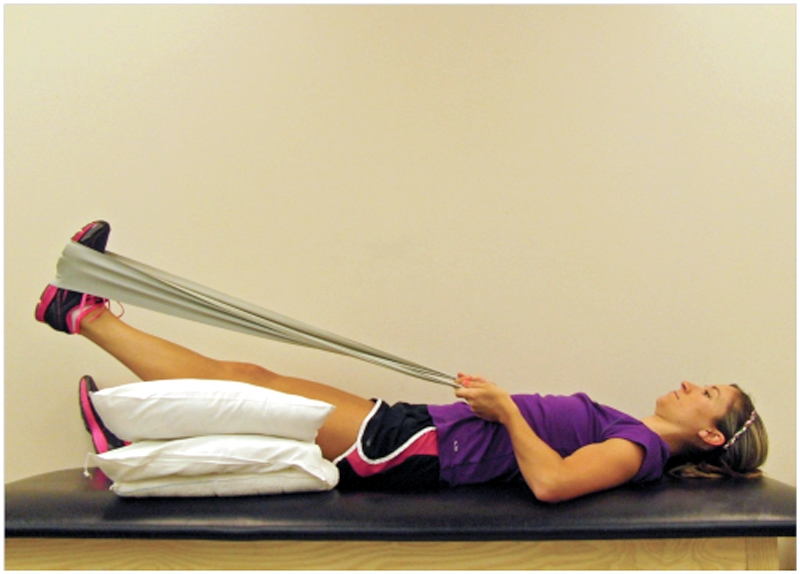
FIGURE 8: STANDING WINDMILLS: (A) START POSITION; (B) FINISH POSITION


Summary
This article is not designed as a self-diagnosis or treatment scheme, but rather to alert you to the fact that a significant number of injuries where pain fails to resolve after treatment, may have neural tension as a complicating or even a main factor. It is also possible that a recurring muscle strain is related to nerve tension, and this should be factored into a treatment plan.Neural tension may arise due to biomechanical problems (eg muscle imbalances) or physiological factors (eg chronic swelling). If this is suspected, one of the first tests that should be carried out is the slump test, followed with neural mobilisations such as nerve slides. Nerve slides alone aren’t always a complete cure, but can be a large contributor to a return to fitness. In addition to nerve slides, joint mobilisations, soft tissue release techniques and muscle stability exercises are also likely to be needed to allow a full return to function. As always, a physiotherapist should always be your first port of call to help guide and direct you through this process.
You need to be logged in to continue reading.
Please register for limited access or take a 30-day risk-free trial of Sports Performance Bulletin to experience the full benefits of a subscription. TAKE A RISK-FREE TRIAL
TAKE A RISK-FREE TRIAL
Newsletter Sign Up
Testimonials
Dr. Alexandra Fandetti-Robin, Back & Body Chiropractic
Elspeth Cowell MSCh DpodM SRCh HCPC reg
William Hunter, Nuffield Health
Newsletter Sign Up
Coaches Testimonials
Dr. Alexandra Fandetti-Robin, Back & Body Chiropractic
Elspeth Cowell MSCh DpodM SRCh HCPC reg
William Hunter, Nuffield Health
Keep up with latest sports science research and apply it to maximize performance
Today you have the chance to join a group of athletes, and sports coaches/trainers who all have something special in common...
They use the latest research to improve performance for themselves and their clients - both athletes and sports teams - with help from global specialists in the fields of sports science, sports medicine and sports psychology.
They do this by reading Sports Performance Bulletin, an easy-to-digest but serious-minded journal dedicated to high performance sports. SPB offers a wealth of information and insight into the latest research, in an easily-accessible and understood format, along with a wealth of practical recommendations.
*includes 3 coaching manuals
Get Inspired
All the latest techniques and approaches
Sports Performance Bulletin helps dedicated endurance athletes improve their performance. Sense-checking the latest sports science research, and sourcing evidence and case studies to support findings, Sports Performance Bulletin turns proven insights into easily digestible practical advice. Supporting athletes, coaches and professionals who wish to ensure their guidance and programmes are kept right up to date and based on credible science.





